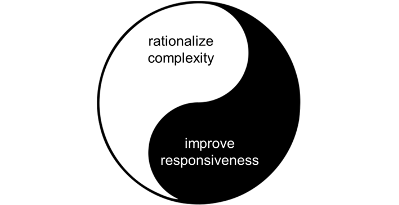Responsive when required, efficient when possible

Competition is more global and fiercer than ever. Not many companies are able to dominate the market and hence for most companies cost price is a ‘qualifier’. If your product is too expensive, you’re out. Efficiency is a necessity.
On the other hand the market requires more and more service. Product ranges are widened, product life cycles are shortened. A company needs the ability to react quickly to market opportunities in order to stay ahead or keep up with competition. Responsiveness is a necessity.
But didn’t they teach us that efficiency and responsiveness are repelling forces? That is either/or instead of and/and. Doesn’t efficiency come with large batches, high MOQs, sourcing from the Far East resulting in long lead times and aiming for a 100% utilization rate? How can this possibly go hand in hand with the speed and flexibility needed for responsiveness?
We propose a new paradigm: “Responsive when required, efficient when possible”. To achieve this, we need to start thinking differently. Indeed, “if you always do what you always did, you will always get what you always got”.
We need to let go of the old truths that are obstructing our success. We need to start thinking about what the customer wants instead of what we can deliver. We need to start thinking about the results instead of the costs. We need to start thinking about the hand instead of the individual fingers.
The starting point for this new way of thinking is customer value. The central question which needs to be answered every time is: is our customer willing to pay for this? By asking this question over and over, you can distinguish between good and bad complexity. Good complexity is complexity for which the customer is willing to pay. A wide product range does not need to be a problem, if it offers sufficient strategic value. On the contrary, bad complexity is complexity we impose upon ourselves, for instance due to a bad planning process or counterproductive targets.
It sounds simple, but bad complexity needs to be reduced. One company may start with a portfolio harmonization project improving the strategic value of the product range while another company may initiate a Lean project to reduce process variability. And yet another company might benefit more from improving the demand forecast, rethinking customer agreements or implementing an effective S&OP process. Hence, efficient when possible. And it cuts both ways. Reducing bad complexity not only reduces costs but also creates possibilities to add good complexity.
The other side of the story is that good complexity needs to be accommodated since it represents customer value. To do so, responsiveness needs to be increased. With straightforward measures it is often possible to improve a lot. By placing the right buffers (in time, inventory or capacity) in the right places or by having a good rule to decide which items to produce to order and which to produce to stock. A QRM project may help to shorten throughput times. Hence, responsive when required.
“Responsive when you must, efficient when you can” is a diverse approach to outperform the competition. The key is finding the right lever, the place where the biggest steps can be made. By keeping an open mind one can prevent sub-optimization and find the overall best solution. It isn’t an approach for just the operations department, often pushing for higher efficiency, nor an approach for just the sales department, often pushing for more responsiveness, but an approach that binds and unites these departments.



